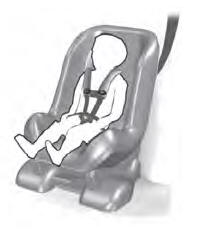Lincoln Aviator: Tire Care / Inspecting Your Tires and Wheel Valve Stems
Periodically inspect the tire treads for uneven or excessive wear and remove objects such as stones, nails or glass that may be wedged in the tread grooves. Check the tire and valve stems for holes, cracks, or cuts that may permit air leakage and repair or replace the tire and replace the valve stem. Inspect the tire sidewalls for cracking, cuts, bruises and other signs of damage or excessive wear. If internal damage to the tire is suspected, have the tire demounted and inspected in case it needs to be repaired or replaced. For your safety, tires that are damaged or show signs of excessive wear should not be used because they are more likely to blow out or fail.
Improper or inadequate vehicle maintenance can cause tires to wear abnormally. Inspect all your tires, including the spare, frequently, and replace them if one or more of the following conditions exist:
 Recommended Tire Pressures and Inflating Your Tires
Recommended Tire Pressures and Inflating Your Tires
Safe operation of your vehicle requires
that your tires are properly inflated.
Remember that a tire can lose up to half
of its air pressure without appearing flat...
 Tire Wear. Damage
Tire Wear. Damage
Tire Wear
When the tread is worn down to one
sixteenth of an inch (2 mm), tires must
be replaced to help prevent your vehicle
from skidding and hydroplaning...
Other information:
Lincoln Aviator 2020-2026 Service Manual: General Procedures - Piston Diameter
Check Measure the piston diameter 90 degrees from the piston pin and piston diameter (DN) height down from the top of the piston at the point indicated. Refer to specifications for the piston diameter (DN) height. Refer to: Specifications (303-01A Engine - 3...
Lincoln Aviator 2020-2026 Service Manual: Removal and Installation - Roof Opening Panel Shield
Removal NOTE: Removal steps in this procedure may contain installation details. Remove the roof opening panel frame. Refer to: Roof Opening Panel Frame (501-17 Roof Opening Panel, Removal and Installation). Remove the front cross bar from the couplers on both sides...
Categories
- Manuals Home
- Lincoln Aviator Owners Manual
- Lincoln Aviator Service Manual
- Changing the Front Wiper Blades - Vehicles With: Heated Wiper Blades
- Keyless Entry
- Anti-Theft Alarm
- New on site
- Most important about car
Child Seats

Use a child restraint (sometimes called an infant carrier, convertible seat, or toddler seat) for infants, toddlers and children weighing 40 lb (18 kg) or less (generally four-years-old or younger).
Using Lap and Shoulder Belts
WARNING: Do not place a rearward facing child restraint in front of an active airbag. Failure to follow this instruction could result in personal injury or death.
